Abstract
The Gacun deposit is a typical Volcanic Hosted Massive Sulfide (VHMS) associated with Late Triassic seafloor calc-alkaline felsic volcanics. Studies of zircon ages, petrology, major and trace element geochemistry, and Sr-Nd-Hf isotope geochemistry of volcanic rocks from the Northern Yidun arc were undertaken in this paper. We reshaped the Gacun magmatic system activity time, defined the origin of magma evolution, and proposed a metallogenic model of the deposit. Whole-rock major element compositions of the magmatic rocks in the Northern Yidun island arc indicate that they are a complete basalt–andesite–dacite–rhyolite assemblage, showing three obvious stages of composition evolution. They are enriched in large-ion lithophile and light rare earth elements, but depleted in high field-strength and heavy rare earth elements, with weak-to-negligible Eu anomalies (obvious in rhyolite). These geochemical features indicate that the Northern Yidun island arc is a magmatic arc based on ancient continental crust. The Ganzi–Litang oceanic subduction induced mantle melting and produced calc-alkaline basaltic magma, while the MASH processes at the bottom of the crust produced andesitic magma. Part of the andesite magma erupted to form andesite lava. The remaining part was mixed with magma produced via anatexis of ancient crust (approximately 20%–40% of the ancient crustal component), forming the ore-bearing rhyolite. Zircon U-Pb age data defines Gacun magmatic–hydrothermal mineralization sequence of events: At 238 Ma, arc magmatism led to the formation of andesite in the eastern part of the deposit. At 233 Ma, in the arc zone (the western part of Gacun deposit), a large-scale bimodal magmatism formed the main ore-bearing rock series of Gacun deposit, rhyolitic volcanic rocks. At 221 Ma, volcanic eruptions tended to end and sub-volcanic intrusion occurred, forming a lava dome, which was located under the ore-bearing rhyolitic volcanic rocks. The lava dome acted as a thermal engine and promoted hydrothermal circulation. The hydrothermal activity reached a peak at 217 ± 1 Ma, and the Gacun VHMS deposit was formed.
1. Introduction
The Gacun Ag-Pb-Zn-Cu deposit is located in Sichuan Province, which is, in turn, located in southwestern China. It is one of the giant VHMS deposits found in China and contains total proved reserves of 1570 Mt. at an average ore grade of 0.40% Cu, 3.24% Pb, 5.27% Zn, and 84.78 g/t Ag (internal data of mining company). The accurate age of the mineralization event in ore deposits and related magmatic properties are crucial for helping economic geologists to understand the ore-forming process and genesis. Due to the mineralization event involving the Volcanic Hosted Massive Sulfide (VHMS), deposits are usually considered to be synvolcanic, and the metallogenic age is usually constrained by the dating of host volcanic rocks or fossil strata. Xu et al., (1993) [1] considered that the Gacun deposit formed in the Late Triassic as fossil strata. The Re-Os isotopic compositions of sulfide ores in the Gacun deposit were analyzed [2] to constrain the timing of mineralization, and all sulfide samples yielded an isochron with an age of 217 ± 28 Ma. However, in the process of hot water circulation, host rocks commonly experienced metamorphism and alteration to various degrees. Therefore, the age of mineralization given through traditional dating methods (such as Rb-Sr and K-Ar methods) tends to be somewhat different from the real age. VHMS deposits are often considered to be related to volcanism; thus, determining the nature and age of volcanic rocks related to mineralization is important to understanding mineralization.
Zircon, which is a ubiquitous accessory mineral found in feldspathic rocks, is extremely resistant to later geological processes and can survive post-crystallization thermal disturbances [3,4,5]. It is a mineral well suited not only to U-Pb dating, but also to hafnium isotopic studies [6]. Furthermore, the Lu-Hf isotopic system can be utilized to track the history of chemical differentiation in the Earth (crust and mantle) by virtue of the fact that fractionation of Lu from Hf occurs during magma generation [7]. Recent studies show that hafnium isotopic compositions of zircon can elucidate the nature of magma sources and the role of magma mixing processes in the generation of granitoids [8,9,10,11,12,13]. Therefore, zircon Lu-Hf isotopes and whole rock Sr-Nd isotopes are also powerful tools for studying rock genesis and crustal evolution.
Sampling in the Gacun deposit is difficult due to its location at a high altitude. Previous studies mainly focused on the tectonic evolution, thermal history, and mineralization of the Northern Yidun arc [14,15,16,17]. Much less attention has been paid to the geochemical characteristics and petrogenesis of the Late Triassic volcanic rocks in the arc, and in situ zircon U-Pb, Hf, and whole-rock Sr-Nd isotopic data gathered from the ore-bearing rock series found within it had not been reported. Therefore, we collected the relatively fresh basalt, andesite, and rhyolite from the periphery of the deposit (Northern Yidun arc), and rhyolite was collected from the semi-layered lower stringer zone of the sheet-like massive sulfide zone in the deposit. This paper carried out detailed petrology, as well as in situ zircon U-Pb-Hf isotopic and whole-rock Sr-Nd isotopic analyses, on these lithologies. On the basis of these data, we limited the magma evolution process related to the mineralization of the Gacun deposit and established detailed magmatic–hydrothermal activity processes.
2. Geological Setting and Ore Geology
The Gacun deposit is located in the northwest of Sichuan province, China, and the geotectonic structure belongs to the Yidun Island arc collisional orogenic belt found in both the western part of the Songpan–Ganzi fold system and the eastern part of Tethys-Himalayan tectonic belt [16]. It experienced a long tectonic evolution process from the Late Triassic to the Mesozoic orogenic belts (Figure 1) [17].
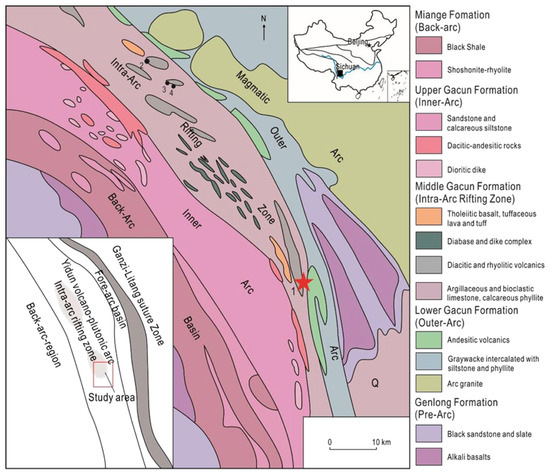
Figure 1.
Regional geological map of the Gacun district showing major tectonic units, volcano-sedimentary sequences, and the location of the VHMS deposits. Inset map shows the tectonic framework of the Yidun arc, which stemmed from westward subduction of the Ganzi–Litang oceanic lithosphere. 1 = the Gacun deposit, 2 = the Cayiqong deposit, 3 = the Ronghong deposit, 4 = the Kaigong deposit. Modified by Hou et al., 2001 [17].
The Gacun deposit, which is the largest known VHMS deposit in the area, lies in the Changtai volcano-sedimentary basin, which is about 20 km long and 8 km wide. The basin was formed during the intra-arc rifting phase and filled by a volcano-sedimentary sequence of the Middle-to-Upper Gacun Formation, which is characterized by bimodal volcanic suite (Figure 2a) [17]. The development pattern of the Gacun deposit is very similar to those of VHMS deposits in Japan, which are concentrated in the continental orogenic belt; thus, the Gacun deposit belongs to the VHMS deposit. The bimodal volcanic suite is composed of mafic volcanic rocks from the tholeiitic basalt series and felsic volcanic rocks from the calc-alkaline series. The mafic rocks are 50–250 m thick and overlie sedimentary rock layers, which are located in the lower part of the bimodal volcanic suite, that consist of basaltic volcanic rocks and an associated dike swarm. The basaltic rocks include the lower tholeiitic basalt rocks and the upper tuffaceous unit, which are symmetrically distributed on the two wings in the NNW direction [17]. The tuffaceous unit is mostly porous, and most of the pores are filled with hydrothermally altered minerals (such as chlorite, calcite, and quartz) and metallic sulfides (such as pyrite, galena, and sphalerite), which show obvious hydrothermal activity. The felsic volcanic series are ore-bearing rocks, which were produced in the upper part of the bimodal volcanic suite, that occupy a very large area, with an at least 1000-m thick section extending along the NNW direction for about 14 km. According to the detailed geological mapping and borehole features by Hou et al., (2001) [17], the felsic volcanic series is divided into two parts, which have a fault contact between them. The lower felsic unit (LFU) is mainly composed of dacite and dacite–rhyolite, and the upper felsic unit (UFU) is symmetrically exposed on both flanks of the NNW anticline and pre-dominated by rhyolite pyroclastic rocks.
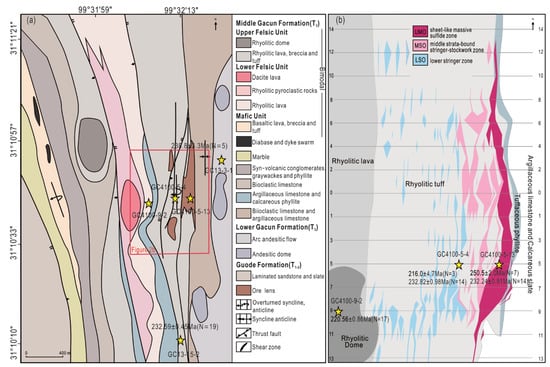
Figure 2.
(a) Geologic map of the Gacun deposit showing the distribution of orebodies, major volcanic units, and sampling locations. (b) The location of the samples of mineralized zones at different locations (No. GC4100-9-2, GC4100-5-4 and GC4100-5-13). The yellow stars are the sample locations.
Exhalite and exhalative sedimentary rocks in VHMS deposits have a very close relationship with mineralization. The exhalite and exhalative sedimentary rocks in the Gacun deposit are mainly produced at the top of the ore-bearing unit and coeval with the massive sulfide ore. The exhalite in the Gacun deposit is mainly barite rocks, followed by siliceous rocks and jasper rocks. The exhalative sedimentary rocks are mainly dominated by limestone and dolomite, which are usually coeval with calcareous slate [15].
According to the characteristics of the rock series, the mineralization horizon, and the mineral structure, the Gacun deposit consists of three main mineralized zones: an upper massive zone (UMO) produced in the interlayer with exhalite and exhalative sedimentary rocks, a middle stringer-stockwork zone (MSO) within the rhyolite pyroclastic subunit (i.e., UFU), and a lower stringer zone (LSO) that occurs in the dacite rhyolite volcanic subunit (i.e., LFU) [14]. The massive ore is located in the upper of the rhyolite series, is produced in a stratiform or a long lens body [16], and directly overlies the lower stockwork sulfide orebodies. It is dominated by lead–zinc and silver–copper–lead–zinc ore [18]. The stockwork sulfide orebodies mainly occurred in the rhyolite, which were dominated by lead-zinc ore (Figure 2b).
3. Samples and Analytical Methods
3.1. Sampling
In order to study the magmatic events related to the formation of the Gacun deposit, we collected samples from the basalt, basalt–andesite, and andesite that were exposed to the surface about 2 km west of the Gacun deposit, as well as from the fresh rhyolite of the riverside, which was located about 1.5 km away from the deposit, and the ore-bearing rhyolite from the bottom of the semi-layered lower stringer zone (LSO) in the sheet-like massive sulfide zone (UMO). Almost all samples were selected for whole-rock major and trace element analyses and Sr-Nd isotopic analyses. Zircon U-Pb dating and Hf isotopic analysis were performed on andesite and rhyolite samples. Detailed sample locations are provided in Figure 2. Photomicrographs are provided in Figure 3.

Figure 3.
Photomicrographs of the various volcanic rocks in the Gacun deposit (a) Calcite in trachy basalt. (b) Quartz and epidote in andesite. (c) Dissolved harbor-like plagioclase phenocryst with porphyritic texture in basaltic andesite. (d) Quartz and calcite in dacite. (e,f) Feldspar phenocryst with porphyraceous texture in rhyolite. Abbreviations: Cal = calcite; Ep = epidote; Qtz = quartz; Pl = plagioclase; Afs = alkalifeldspar.
These samples were made into polished thin sections (30–40 μm thick) that were studied using reflection and transmission optical microscopes, and 200 mesh powder was prepared for major, trace element, and Sr-Nd isotopic analyses. They were also pulverized to the left and right via conventional methods, and after reselection and enrichment via elution, as well as magnetic separation and density sorting, the zircon was further separated and extracted under the binocular lens and fixed onto the sample target using epoxy resin. After grinding and polishing, a fresh section of zircon was exposed, carbon was sprayed, and a cathodoluminescence photomicrograph was performed using a scanning electron microscope.
3.2. Major and Trace Element Analyses
The whole-rock major element concentrations of the samples were determined using fused glass discs and an X-ray fluorescence (XRF) spectrometer (Shimadzu XRF-1500) at the National Research Center for Geoanalysis, the Chinese Academy of Geological Sciences, Beijing, China. The operating conditions included a current of 50 mA and a voltage of 50 kV. The analytical precision of the major oxide measurements, which was based on the analyses of certified standards (GSR-1, GSR-3) and duplicate analyses, was expressed in terms of relative percentages ranging from ±0.01% to ±0.20%. Ferric and ferrous iron measurements were performed using wet chemical analyses.
The concentrations of trace elements were determined through inductively coupled plasma-mass spectrometry (ICP-MS) using an Agilent 7500a system at the National Research Center for Geoanalysis, Beijing. Bulk rock powders (50 mg) were weighed and dissolved in 1 mL of distilled HF (1.5 g/mL) and 0.5 mL of HNO3 (1.41 g/mL) in Teflon-lined stainless steel bombs. The sealed bombs were then placed in an oven and heated to 190 °C for 24 h. After cooling, the bombs were opened and placed on a hot plate to evaporate to dryness at 200 ℃. The residue was dissolved by adding an HNO3 solution, and the bombs were resealed and heated to 130 ℃ for 3 h. The final solutions were transferred into plastic beakers and diluted prior to analysis. International rock standards (BCR-1, BHVO-1, AGV-2, and JB-1) were analyzed to monitor the mass drift that occurred during MS measurements. The duplicate analyses of standards indicated that the precision levels for most trace elements were better than 5%.
3.3. Zircon U-Pb Dating
U-Pb dating analyses were conducted via LA-ICP-MS at the Ministry of Natural Resources Key Laboratory of Metallogeny and Mineral Assessment, the Institute of Mineral Resources, CAGS, Beijing. Detailed operating conditions for the laser-ablation system and the ICP-MS instrument and data reduction were described by Hou et al., (2009) [19]. Laser sampling was performed using a Resolution S155 193-nm laser-ablation system. A Bruker M90 ICP-MS instrument was used to acquire ion–signal intensities. Helium was applied as a carrier gas. Argon was used as the make-up gas and mixed with the carrier gas via a T-connector before entering the ICP. Each analysis incorporated a background acquisition of −15 s (gas blank), followed by 45 s of data acquisition from the sample. Off-line raw-data selection, integration of background and analyte signals, time-drift correction, and quantitative calibration for U-Pb dating were performed via ICPMSDataCal software [20].
Zircon GJ-1, which was used as the external standard for U-Pb dating, was analyzed twice every 5 to 10 analyses. Time-dependent drifts of U-Th-Pb isotopic ratios were corrected by applying a linear interpolation (with time) for every 5 to 10 analyses according to the GJ-1 variations (i.e., 2 zircon GJ-1, 5 to 10 samples, and 2 zircon GJ-1) [20]. Preferred U-Th-Pb isotopic ratios used for GJ-1 were sourced from Jackson et al., (2004) [21]. Uncertainty regarding the preferred values (±0.5%) for the external standard GJ-1 was propagated to the ultimate sample results. For all analyzed zircon grains, the commonly applied Pb correction was not necessary due to the weak signal for common 204Pb, and the strong 206Pb/204Pb. U, Th, and Pb concentrations were calibrated via NIST 610. Concordia diagrams and weighted-mean calculations were made using Isoplot/Ex_ver3. The zircon Plesovice was dated as a sample unknown and yielded a weighted-mean 206Pb/238U age of 337 ± 2 Ma (2SD, n = 12), which is in good agreement with the recommended 206Pb/238U age of 337.13 ± 0.37 Ma (2SD) [22].
3.4. Zircon Lu–Hf Isotopic Analyses
Zircon Hf-isotope analysis was carried out in situ using a GeoLas Pro 193 laser-ablation microprobe, which was attached to a Neptune multi-collector ICP-MS at the Ministry of Natural Resources Key Laboratory of Metallogeny and Mineral Assessment, the Institute of Mineral Resources, Chinese Academy of Geological Sciences, Beijing. Instrumental conditions and data acquisition were comprehensively described by Hou et al., (2007) [23] and Wu et al., (2006) [24]. A stationary spot was used for the present analyses, with a beam diameter of either 40 or 55 μm depending on the size of ablated domains. Helium was used as the carrier gas to transport the ablated sample from the laser-ablation cell to the ICP-MS torch via a mixing chamber mixed with argon. To correct the isobaric interferences of 176Lu and 176Yb on 176Hf, 176Lu/175Lu = 0.02658 and 176Yb/173Yb = 0.796218 ratios were determined [25]. For instrumental mass bias correction, Yb isotope ratios were normalized to 172Yb/173Yb = 1.35274 [25]. and Hf–isotope ratios to were normalized 179Hf/177Hf = 0.7325. using the exponential law. The mass bias behavior of Lu was assumed to follow that of Yb; the details of the applied mass bias correction protocols were as described by Wu et al., (2006) [24] and Hou et al., (2007) [23]. Zircon GJ-1 was used as the reference standard during our routine analysis, with a weighted-mean 176Hf/177Hf ratio of 0.282007 ± 0.000007 (2σ, n = 36), which is indistinguishable from the weighted-mean 176Hf/177Hf ratio of 0.282000 ± 0.000005 (2σ) used when applying Morel et al.’s (2008) [26] solution analysis method.
3.5. Whole-Rock Sr-Nd Isotopic Analyses
Rb-Sr and Sm-Nd isotopic analyses were performed at the University of Science and Technology of China, Hefei, China, following the procedures described in Chen et al., (2000, 2002, and 2007) [27,28,29]. Whole-rock powders of about 100 mg were weighed and placed in 15 mL Teflon stuffy tanks, before being added with appropriate amounts of 87Rb-84Sr and 149Sm-150Nd tracer solutions. The samples were dissolved in a mixture of 2–3 mL purified HF solution and 8–10 drops of purified HClO4 solution. Decomposition of refractory phases was ensured by heating the samples in Teflon stuffy tank at 120 °C for about 7 days. After the samples were completely dissolved, the sample solutions were dried on a hotplate at 120 °C and then heated to 150 °C to completely remove the HF and HClO4. Next, 3 mL purified 6N HCl solution was twice added into the sample tanks to clear the inside of the tanks, and the solution was once again dried. The sample residues were re-dissolved overnight with 1 mL purified 3N HCl solution to prepare for chemical separation and purification. Rb, Sr, and light rare earth elements were isolated on quartz columns via conventional ion exchange chromatography with a 5 mL resin bed of Bio Rad AG 50W-X12, 200–400 mesh. Nd and Sm were separated from other rare earth elements on quartz columns using 1.7 mL Teflon powder coated with HDEHP, i.e., di (2-ethylhexyl) orthophosphoric acid, as the cation exchange medium. All isotopic measurements were performed via a Finnigan MAT 262 mass spectrometer. Sr was loaded with a Ta-HF activator on pre-conditioned W filaments and measured in single-filament mode. Nd was loaded as phosphate on pre-conditioned Re filaments, and measurements were performed in a Re double filament configuration. The 87Sr/86Sr ratios were normalized to 86Sr/88Sr = 0.1194, and the 143Nd/144Nd ratios were normalized to 146Nd/144Nd = 0.7219. Measurement accuracy of 87Sr/86Sr and 143Nd/144Nd ratios for the samples was greater than 0.003%. Procedural blanks were <100 pg for Sr, Nd, and Pb. During the period of data collection, measurements of the NBS987 and Jndi standard solutions gave a 87Sr/86Sr value of 0.710247 ± 0.000012 (2σm) and a mean 143Nd/144Nd value of 0.512119 ± 0.000008 (2σm), respectively. Results of repeated Rb-Sr and Sm-Nd analyses on the standard material BCR-1 (basalt powder) gave a mean 87Sr/86Sr ratio value of 0.705027 ± 0.000013 (n = 36; Rb 46.54 ppm, Sr 329.5 ppm), as well as a mean 143Nd/144Nd ratio value of 0.512633 ± 0.000007 (n = 45, Sm 6.676 ppm, Nd 28.77 ppm). The external precision is given in 2σ uncertainty based on replicate measurements of these standard materials taken over one year.
4. Results
4.1. Whole-Rock Major and Trace Element Compositions
Different types of magmatic rock samples (LOI = 1.52–3.61 wt.%), i.e., fresh or relatively weak alteration and low-weathering samples, are selected for the determination of major, rare earth, and trace elements. The test results are shown in Table S1.
They are a complete basalt–andesite–dacite–rhyolite assemblage, showing three obvious stages of composition evolution (Table S1, Figure 4a,b): basalt–basaltic andesite, andesite, and dacite–rhyolite. These basalt–basaltic andesite samples are similar to the calc-alkaline basalts in the modern or ancient island arc (or continental marginal arc) [30], with low TiO2 (0.92%–2.37%) and FeO/MgO. Andesite series (mainly andesite and dacite) are similar to middle/high-K andesite in the island arc, with low TiO2 (0.06%–1.03%) and FeO/MgO and high Al2O3 ranging from 11.49% to 18.09%. Moreover, the rhyolite series resemble high-K calc-alkaline rhyolite in the island arc, with low TiO2 (0.11%–0.30%), high Al2O3 (12.93%–14.90%), and high K2O (2.28%–3.98%).
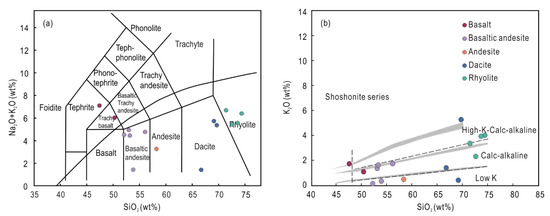
Figure 4.
Total alkali versus SiO2 (TAS): (a) K2O versus SiO2; (b) diagrams for Mesozoic igneous rocks from the Northern Yidun arc.
In the chondrite-normalized REE diagram (Figure 5, according to the standardized data from Sun and McDonough, 1989) [31], the trends of the partition curves of all kinds of igneous rock are generally similar, showing the right sloping flat curves that are strongly enriched in LREE and depleted in HREE. Moreover, they exhibit higher degrees of differentiation between LREE and HREE (LaN/YbN of basalt, andesite, dacite, and rhyolite are 3.96–6.03, 5.52–12.04, 9.57–18.79, and 6.61–10.23, respectively). The dacite samples have the highest differentiation of LREE and HREE. The basalt, andesite, and dacite samples show weak-to-negligible Eu anomalies. The negligible Eu anomalies are obvious in rhyolite, which shows the obvious fractional crystallization of plagioclase during the magmatic process [3].
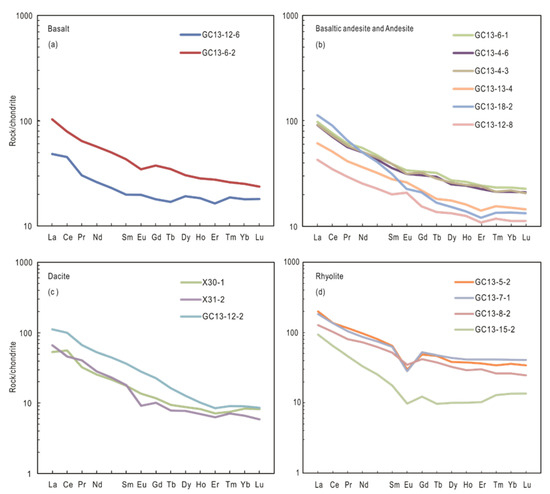
Figure 5.
Chrondrite-normalized rare earth element patterns (REE) for the Gacun volcanic rocks. The REE data from the present study (Supplementary Table S1) are normalized via chondrite values of Sun and McDonough (1989) [31]. (a) basalt, (b) basaltic andesite and andesite (c), dacite, and (d) rhyolite.
All types of igneous rock in the Gacun deposit have high concentrations of LILEs, such as Ba, U, K, and Pb, which are up to 100 times more enriched than those of the primitive mantle; however, they are characterized by relatively low Sr, Cr, and Ni; enriched in HFSEs, such as Th, Ce, and Zr; and depleted in Ta, Nb, P, and Ti (Table S1, Figure 6) [31].
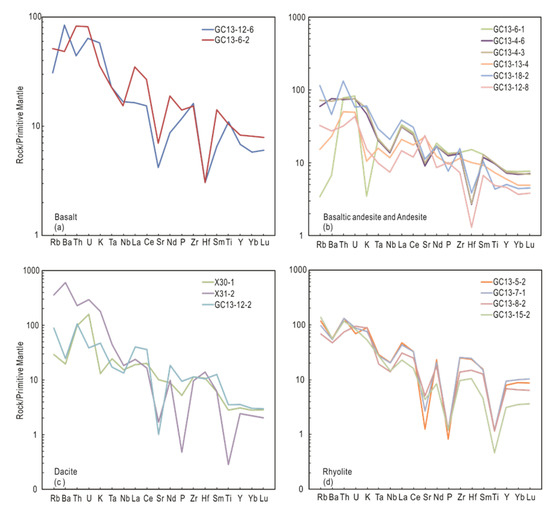
Figure 6.
Primitive mantle-normalized (Primitive mantle normalization values are sourced from Sun and McDonough, 1989) [31] spider diagrams for the Gacun volcanic rocks. Data are sourced from this study (Supplementary Table S1). (a) Basalt (b), basaltic andesite and andesite (c), dacite, and (d) rhyolite.
The Rb/Sr ratios of basalt, andesite, dacite, and rhyolite are 0.22, 0.01–0.31, 0.09–6.55, and 0.48–3.75, respectively. They are higher than the corresponding ratio of the primitive mantle (0.029, according to Sun and McDonough, 1989) [31], indicating a high degree of magmatic differentiation and evolution [32].
4.2. U-Pb Zircon Chronology
One fresh andesite sample (GC13-3-1) and one fresh rhyolite sample (GC13-15-2) collected from the periphery of the Gacun deposit, as well as three rhyolite samples (GC4100-9-2, GC4100-5-4 and GC4100-5-13) collected from different locations of mineralized zones in the Gacun deposit (Figure 2b), were dated using the zircon LA-ICP-MS U-Pb method. The zircon LA-ICP-MS U-Pb isotopic data are given in Table S2 and shown in Figure 7 and Figure 8.
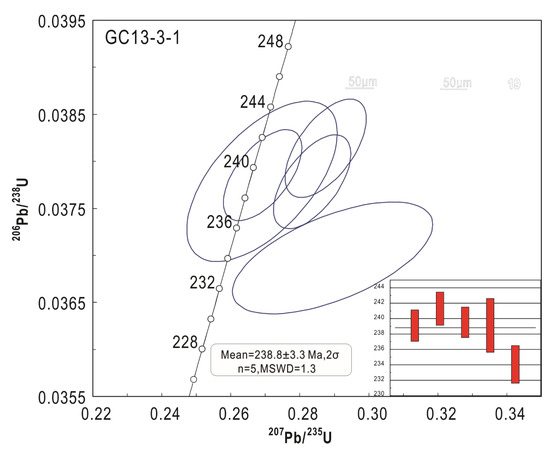
Figure 7.
LA-ICP-MS U-Pb zircon concordia diagrams for the fresh andesite from the periphery of the Gacun deposit (GC13-3-1). Data are sourced from this study (Supplementary Table S2).
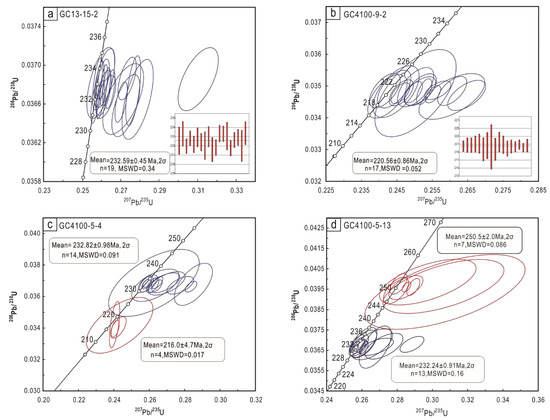
Figure 8.
LA-ICP-MS U-Pb zircon concordia diagrams for (a) the metamorphic rhyolite periphery of the Gacun deposit (GC13-15-2), (b) the metamorphic rhyolite porphyry lower stringer zone (LSO) (GC4100-9-2), (c) the rhyolite clastic rock LSO (GC4100-5-4), and (d) the shallow metamorphic rhyolitic siliceous rock from the sheet-like massive sulfide zone (UMO) (GC4100-5-13). Data are sourced from this study (Supplementary Table S2).
Zircon grains, which are sourced from fresh rhyolite samples from the periphery of the Gacun deposit and rhyolite samples at different locations inside the deposit, are mostly euhedral to subhedral in nature and show short-to-long prismatic forms, with length-to-width ratios ranging from 1:1 to 3:1 and display concentric oscillatory zoning (Figure 9). Except for the andesite sample (GC13-3-1), concentric oscillatory zoning in the cathodoluminescence images is not obvious, showing black and implying high U and Th contents.
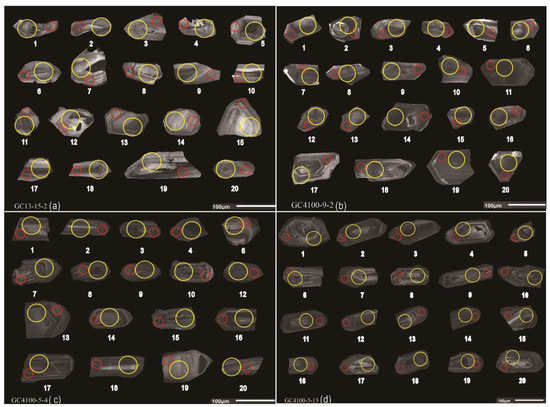
Figure 9.
Cathodoluminescence (CL) images of zircons from (a) the metamorphic rhyolite periphery of the Gacun deposit (GC13-15-2), (b) the metamorphic rhyolite porphyry bottom of the Lower stringer zone (LSO) (GC4100-9-2), (c) the rhyolite clastic rock LSO (GC4100-5-4), and (d) the shallow metamorphic rhyolitic siliceous rock sheet-like massive sulfide zone (UMO) (GC4100-5-13). Yellow circles show positions of Hf isotopic analyses. Red circles show positions of simultaneous LA-ICP-MS measurements of U-Pb ages.
4.2.1. Fresh Andesite and Rhyolite Samples from the Periphery of Gacun Deposit
We analyzed the relatively low U and Th contents of zircon grains from fresh andesite samples (GC13-3-1), though only 5 out of 20 analyses yielded concordant ages. These 206Pb/238U ages range from 222.2 to 241.3 Ma (Table S2), with a weighted mean age of 238.8 ± 3.3 Ma (n = 5), MSWD = 1.3 (Figure 7), which is interpreted as being the crystallization age of andesite.
The fresh rhyolite sample (GC13-15-2) yielded 206Pb/238U ages (based on 19 analyses of zircons) of 231.6–233.4 Ma, with a weighted mean age of 232.59 ± 0.45 Ma (n = 19, MSWD = 0.34) (Table S2, Figure 8a). This age is interpreted as being the crystallization age of fresh rhyolite from the periphery of the Gacun deposit.
4.2.2. Rhyolite from Different Locations of Mineralized Zones
The rhyolitic lava sample (GC4100-9-2) from the bottom of the lower stringer zone (LSO) yielded 206Pb/238U ages (based on 17 analyses of zircons) ranging from 219.7 to 221.5 Ma, with a weighted mean age of 220.56 ± 0.86 Ma (n = 17, MSWD = 0.052) (Table S2, Figure 8b).
The rhyolite sample (GC4100-5-4) from the lower stringer zone (LSO) yielded 206Pb/238U ages (based on 18 analyses of zircons) of 215.8–253.8 Ma (Table S2). Excluding one analysis that yielded an age of 253.8 Ma, 17 analyses gave two weighted mean ages: 216.0 ± 4.7 Ma (n = 4, MSWD = 0.017) and 232.82 ± 0.98 Ma (n = 14, MSWD = 0.091) (Table S2, Figure 8c).
The shallow metamorphic rhyolitic siliceous rock samples (GC4100-5-13) from the sheet-like massive sulfide zone (UMO) yielded 206Pb/238U ages (based on 20 analyses of zircons) of 231.2–251.9 Ma and two concordia ages: 250.5 ± 2.0 Ma (n = 7, MSWD = 0.086) and 232.24 ± 0.91 Ma (n = 13, MSWD = 0.16) (Table S2, Figure 8d). The seven zircons with a weighted average age of 250.5 ± 2.0 Ma are not significantly different from other zircons in the cathodoluminescence (CL) images, and they also exhibit clear oscillatory zoning, with the Th/U ratios ranging from 0.63 to 1.0, which is typical for zircon of magmatic origin. Moreover, we found a site with an age of 253.8 Ma in the LSO rhyolite volcanic rock sample GC4100-5-4, which was formed via magmatic activity before the entire area rhyolite (233 Ma).
4.3. Zircon Hf Isotope
All spots on the zircons used for dating the andesite and rhyolite in different locations were also selected for in situ zircon Hf isotopic analysis. The zircon Hf isotopic data are listed in Table S3, and these data are plotted as εHf(t) values against their ages in Figure 10.

Figure 10.
Zircon Hf isotopic compositions of rhyolite from the periphery and different locations of the Gacun deposit. Data are sourced from this study (Supplementary Table S3).
4.3.1. Fresh Andesite and Rhyolite Samples from the Periphery of Gacun Deposit
Using the fresh andesite samples (GC13-3-1) from the periphery of the Gacun deposit, we could not obtain Hf isotopic data due to the high Yb content of zircons.
For the fresh rhyolite (GC13-15-2) from the periphery of Gacun deposit, the zircons showed variable 176Hf/177Hf ratios of 0.282518–0.28274, as well as εHf(t) values ranging from −3.7 to 4.0. These values corresponded to the crustal model ages of Hf (TDMC), which ranged from 1010 to 1505 Ma.
4.3.2. Samples from Different Locations of Mineralized Zones
The rhyolitic lava samples (GC4100-9-2) from the bottom of the lower stringer zone (LSO) yielded 176Hf/177Hf ratios of 0.282331–0.282653, as well as εHf(t) values ranging from −10.7 to 0.7. These values corresponded to the crustal model ages of Hf (TDMC), which ranged from 1213 to 1934 Ma.
The rhyolite samples (GC4100-5-4) from the lower stringer zone (LSO) yielded 176Hf/177Hf ratios of 0.282341–0.282579, as well as εHf(t) values ranging from −10.1 to −1.7. These values corresponded to the crustal model age of Hf (TDMC), which ranged from 1372 to 1905 Ma.
Shallow metamorphic rhyolitic siliceous rock samples (GC4100-5-13) from the sheet-like massive sulfide zone (UMO) yielded 176Hf/177Hf ratios of 0.282411–0.282683, as well as εHf(t) values ranging from −7.3 to 2.4. These values corresponded to the crustal model ages of Hf (TDMC), which ranged from 1127 to 1738 Ma.
4.4. Sr–Nd Isotopic Systematics
The analyzed results of the whole-rock Sr-Nd isotopes are given in Table S4 and shown in Figure 11. The initial 87Sr/86Sr and εNd(t) values are calculated at their respective zircon U-Pb ages. The basaltic andesite and andesite samples have similar isotopic compositions characterized by relatively high (87Sr/86Sr)i (0.705907–0.706765) and weakly negative εNd(t) (−0.73 to 0.03) values. A trachy basalt sample has a lower (87Sr/86Sr) i (0.704902) and a similar εNd(t) (−0.29) value to those of the above samples. Three rhyolite samples have similar (87Sr/86Sr) i (0.704674–0.705458) values to those of trachy basalt samples, as well as relatively negative εNd(t) (−2.70 to −1.90). The dacite sample is different from the above samples, with a high (87Sr/86Sr) i (0.707821) and a particularly negative εNd(t) (−5.77). The Sr-Nd isotopic compositions of the rhyolite samples overlap those of coeval porphyries at other deposits in the Zhongdian arc (Figure 11a).
5. Discussion
5.1. The Eruption Timing of the Volcanic Rocks from the Gacun Deposit
The zircons of fresh andesite (GC13-3-1) from the periphery of the Gacun deposit are characterized by a short columnar shape and high U and Th contents. Five magmatic zircons were found with a weighted mean age of 238.8 ± 3.3 Ma, which represents the crystallization age of andesite, in turn reflecting the fact that the earliest arc magmatism in the Yidun island arc started at 239 Ma, which is consistent with the arc magmatic activity time obtained by previous studies based on regional structure–stratigraphic petrography correlation [17]. Zircons from fresh rhyolite (GC13-15-2) from the periphery of the Gacun deposit have a clear oscillatory ring structure (Figure 8a), and their Th/U ratio is >0.4. They are typical magmatic crystalline zircons. Their weighted mean age is 232.59 ± 0.45 Ma, reflecting the large-scale eruption of rhyolitic magmatism after regional andesite. However, considering the differences in morphology and composition between magmatic zircons from fresh rhyolite (GC13-15-2) and magmatic zircons from andesite (GC13-3-1), we speculate that andesite produced via the separation and crystallization of basaltic magma may have experienced crustal material mixing or crustal melt mixing to form 233 Ma rhyolite.
In the lower stringer zone (LSO), the 206Pb/238U-weighted mean age of rhyolite (GC4100-5-4) is 232.82 ± 0.98 Ma (Figure 8c), which is consistent with that of fresh rhyolite (GC13-15-2) from the periphery of the Gacun deposit. The 206Pb/238U-weighted mean age of zircons in the rhyolite clastic rocks (GC4100-5-13) from the sheet-like massive sulfide zone (UMO) is 232.24 ± 0.91 Ma (Figure 8d), which is also consistent with that of fresh rhyolite (GC13-15-2) from the periphery of the Gacun deposit. These data show that the magmatic zircon U-Pb ages of mineralized rhyolite in the deposit and fresh rhyolite from the periphery of the deposit are almost similar, reflecting the fact that the rhyolite in the Gacun deposit is the product of regional rhyolite magmatism in the Yidun island arc.
It is particularly noteworthy that the zircon U-Pb age of rhyolite (GC4100-9-2) at the bottom of the lower stringer zone (LSO) is 220.56 ± 0.86 Ma (Figure 8b), which is significantly younger than that of the rhyolite (GC4100-5-13) from the sheet-like massive sulfide zone (UMO); this finding is contrary to the geological logic. Petrographic observation shows the crystal growth ring structure of analyzed zircons, while it does not show the morphological structure and composition characteristics of hydrothermal zircons, reflecting the belief that the zircon U-Pb age should represent its crystallization age. In addition, the bottom rhyolite has a massive structure and a micro-porphyritic structure, which is significantly different from that of the overlying mineralized rhyolitic pyroclastic rock. It is likely that a lava dome intruded into the overlying rhyolitic volcanic rock. Therefore, 221 Ma should represent the time of either the second magmatic emplacement in the Gacun deposit or the end of rhyolite eruption. Considering the close association between the lava dome and mineralization, we speculate that the metallogenic hydrothermal activity in the Gacun deposit started at 221 Ma.
There are three zircons with a 206Pb/238U-weighted average age of 216.0 ± 4.7 Ma, in addition to the main age (232.82 ± 0.98 Ma) of rhyolite (GC4100-5-4) in the lower stringer zone (LSO) (Figure 8c). However, it is consistent with the Rb-Sr isochron age (217 Ma) [33], as well as the Re-Os isochron age (217 ± 12 Ma) [2] determined via sulfide and sulfate samples. It is also coeval with the late Triassic metallogenic event, as determined by fossil strata [1]. These results indicate that 217 ± 1 Ma represents the age of the main metallogenic events in the Gacun deposit.
In summary, combined with regional geological information and zircon U-Pb age data obtained in this paper, the following magmatic–hydrothermal mineralization sequence of events can be defined in the Gacun deposit: At 238 Ma, arc magmatism led to the formation of andesite in the eastern part of the Gacun deposit. At 233 Ma, in the arc zone (the western part of the Gacun deposit), a large-scale bimodal magmatism formed the main ore-bearing rock series of the Gacun deposit: the rhyolitic volcanic rocks. At 221 Ma, volcanic eruptions tended to end, and sub-volcanic intrusion occurred, forming a lava dome, which was located under the ore-bearing rhyolitic volcanic rocks. The lava dome acted as a thermal engine and promoted hydrothermal circulation. The hydrothermal activity reached a peak at 217 ± 1 Ma, and the Gacun VHMS deposit was formed.
5.2. Nature of the Magma Source and the Petrogenesis of Volcanic Rocks from Gacun Deposit
In the Gacun deposit, no matter the nature of the fresh rhyolite from the periphery, as well as the rhyolitic lava containing ore pyroclastic rock, their εHf(t) shows a large variation range that extends from −10.7 to 4.0 (Figure 10). Correspondingly, the TDMc value also shows a wide range (1010–1934 Ma), with two peak values recorded at 1150 Ma and 1500 Ma, which corresponds to Meso-proterozoic-era rock (Figure 12). It can be clearly seen from Figure 10 that the lowest εHf(t) of rhyolitic rocks is about −10, which is consistent with the ancient lower crustal evolution line at 233 Ma, indicating that the low εHf(t) source may be the ancient crustal material. The high εHf(t) value of rhyolitic rocks varies from 1 to 4, which is close to or slightly lower than the depleted mantle value (Figure 10). This finding means that the high εHf(t) end element is likely to be either a mantle-derived component or a mantle-derived magma that is involved in crustal components or contaminated by crustal materials.
Rhyolite samples have relatively high K2O (2.28–3.98 wt.%, average 3.37 wt.%), total alkali values (Na2O + K2O, 5.42–6.66 wt.%), and LILE (such as Rb, Ba and K) concentrations (Figure 6). Their high-K characteristics may be related to crustal contaminations [34]. Furthermore, their (87Sr/86Sr)I (0.704674–0.705458), εNd(t) (−2.70 to −1.90), and εHf(t) values (fresh rhyolite from the periphery: −3.7 to 4.0; rhyolite at different locations in the deposit: −10.7 to 2.4) reflect additional input of ancient crustal materials. In the Sr-Nd (Figure 11a) isotopic diagrams, the Gacun volcanic rock samples plot along a mixing curve between an inferred depleted mantle component and the ancient Yangtze lower crust. From these data, we infer that the Gacun volcanic rocks are a mixture of 60%–80% mantle material, with additions of 20%–40% ancient crustal materials.
Thorium (Th) is an incompatible element during the partial melting of no-matter subducting sediments or slabs [35], and it is also an immobile element compared to Ce and Sr during fluid activities [36,37]. Thus, fluids derived from the dehydration of subducting pelagic sediments are expected to have lower Th/Ce ratios but higher Sr/Th ratios, while partial melts from the subducting sediments would have higher Th/Ce ratios but lower Sr/Th ratios, as shown in the Th/Ce vs. Sr/Th diagram (Figure 11b). Most of the volcanic rock series samples from the Northern Yidun arc are plotted very close to the pelagic sediments (GLOSS), implying that partial melts, rather than fluids from the subducting sediments, are important contributors to the parental magma.
In summary, the Northern Yidun island arc is a magmatic arc based on ancient continental crust. The Ganzi–Litang oceanic subduction induced mantle melting and produced calc-alkaline basaltic magma, while MASH processes at the bottom of the crust produced andesitic magma. Part of the andesite magma erupted to form andesite lavas. The remaining part was mixed with magma produced via anatexis of ancient crust (approximately 20%–40% of ancient crustal component), forming the ore-bearing rhyolite.
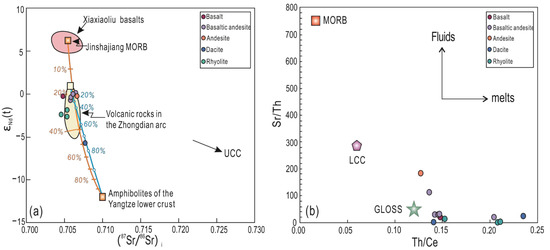
Figure 11.
(a) (87Sr/86Sr)i and εNd(t) for the Gacun volcanic rocks (modified from Cao et al., 2018) [34]. (b) Th/Ce and Sr/Th for the Gacun volcanic rocks. Data are sourced from this study (Supplementary Table S4; modified from Leng et al., 2014) [38]. UCC: upper continental crust [39]; GLOSS: global subducting sediment [40]; LCC: lower continental crust [41]; MORB: mid-ocean ridge basalt [31].
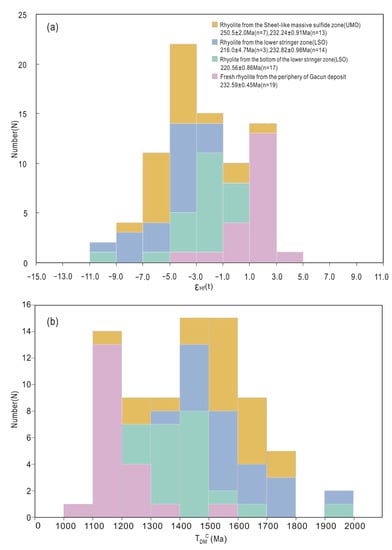
Figure 12.
(a) Histograms of εHf(t) and (b) TDMC model ages of rhyolite from the periphery and different locations of the Gacun deposit. Data are sourced from this study (Supplementary Table S3).
5.3. Ore-Bearing Rock Series and Magmatic Evolution Sequence
The Yidun island arc is a late Triassic magmatic arc formed through the subduction of the Ganzi–Litang ocean basin [34,42,43,44,45]. Although the magmatic arc has island arc properties, there is no credible evidence regarding whether it is based on ocean or continental crust. In this paper, the magmatic zircon Hf isotopic composition of a series of rhyolite sourced from the Gacun deposit and its periphery is systematically measured. The calculated crustal Hf model age changes from 1010 to 1934 Ma, belonging to Meso-proterozoic rock. This finding shows that the Gacun rhyolite series and the Yidun island arc volcanic rocks originated from the continental crust source area, with the ancient crust being the main body, which further proves that the Yidun island arc was developed on the basement of an ancient continental crust and belongs to a continental arc, rather than belonging to an island arc in the real sense.
Based on the study of regional lithostratigraphy and Re-Os chronology [2], previous studies preliminarily established the magmatic sequence of the Northern section of the Yidun island arc (Changtai arc) and Gacun deposit. They pointed out that the andesite that developed in the eastern part of the Gacun deposit was formed in the Late Triassic era, and the magmatic activity then migrated to the back arc area around 217 Ma and mainly developed in the Gacun deposit. A “bimodal rock” combination composed of basalt and rhyolite (dacite) was formed in the inter-arc rift basin [17]. Next, the Gacun VHMS deposit was formed via the deposition of black rock series and submarine hydrothermal activity in the Late Triassic era [2]. Due to the lack of accurate chronological data, the above magmatic sequence is speculative. The zircon U-Pb chronological data obtained in this paper provide a fine limit to this process (Figure 13).
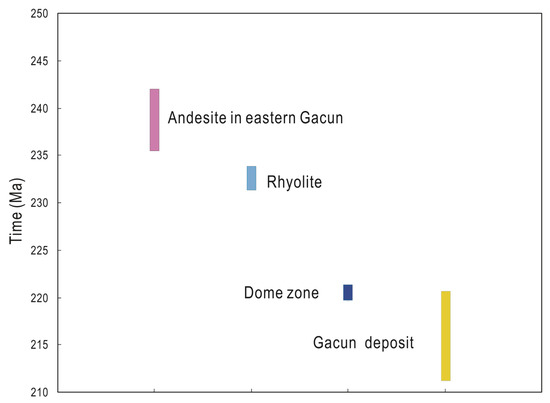
Figure 13.
Geochronology events of the Northern Yidun island arc and the formation of the Gacun deposit.
Our zircon U-Pb chronological data show that the calc-alkaline andesite that developed on the “andesite line” in the eastern part of the deposit has a formation age of 238 Ma (Figure 13), which is equivalent to the late Middle Triassic or early Late Triassic eras, and is connected to the subduction time of the Ganzi–Litang ocean basin and the formation time of regional underlying volcanic rock series (Rootlong group). The zircon U-Pb ages of both regional fresh rhyolites from the periphery of deposit and ore-bearing rhyolitic pyroclastic rocks found in the deposit are highly consistent, being 233 Ma (Figure 13), thus indicating that bimodal rock assemblages dominated by rhyolites were developed in the inter arc rift in the early Late Triassic era. In this deep-water rift basin, rhyolitic pyroclastic rocks form the Gacun ore-bearing volcanic rock series.
According to the lithogeochemical data and the Sr-Nd-Hf isotopic composition of andesite and rhyolite, this paper proposes that the mantle melting induced through the subduction of Ganzi–Litang oceanic plate produced calc-alkaline basaltic arc magma, which rose to the bottom of the crust, where a MASH zone could form. Basaltic magma evolved into andesitic magma. Next, the andesitic magma mixed with the acidic magma produced through the melting of ancient crust to form rhyolitic volcanic rocks.
Importantly, lithofacies’ characteristics of rhyolite in the bottom of the lower stringer zone (LSO) are similar to those of the lava dome, which may represent the intrusion facies of rhyolitic magma. The magmatic zircons of rhyolite yield a U-Pb isotopic age of 221 Ma (Figure 8b), which is consistent with the 217 Ma age determined according to fossil strata [1] and Re-Os isochron age [2]. In view of the strong silicification and quartz-sericitization of the rhyolite, which is accompanied by vein network vein mineralization, we believe that this rhyolite lava dome acted as a “heat engine” to drive the submarine hydrothermal convection cycle, reaching a peak at around 217 ± 1 Ma, followed by sulfide mineral precipitation to form the Gacun VHMS deposit (Figure 13).
6. Conclusions
We draw the following conclusions based on our combined studies of zircon U-Pb ages and Hf isotopes, whole-rock geochemistry, and Sr-Nd isotopes for the Late Triassic-era volcanic rocks in the Gacun deposit.
- (1)
- Using the zircon U-Pb age data obtained in this paper, we define the Gacun magmatic-hydrothermal mineralization sequence of events: At 238 Ma, arc magmatism led to the formation of andesite in the eastern part of the Gacun deposit. At 233 Ma, the ore-bearing rhyolite series formed. At 221 Ma, sub-volcanic intrusion occurred, forming a lava dome, which was located below the ore-bearing rhyolitic volcanic rocks. The lava dome acted as a thermal engine and promoted hydrothermal circulation. The hydrothermal activity reached a peak at 217 ± 1 Ma, and the Gacun VHMS deposit was formed.
- (2)
- The trace element geochemical and Sr-Nd-Hf isotopic characteristics suggest that different components were involved in the generation of the parental magmas of the volcanic rocks in the Northern Yidun arc, including melts generated via subducting sediments and components from lower crust generated via contamination, of which the lithospheric mantle is the dominant component.
- (3)
- Using geochemistry, whole-rock Sr-Nd isotopic analyses and in situ zircon Hf isotopic tests elucidated the source of magma and the evolution process of the Gacun deposit. The study indicates that the Yidun island arc is based on ancient continental crust. Calc-alkaline basaltic magma may have occurred via MASH processes at the bottom of the crust, and andesitic magma was formed. Part of the element became andesite, and the remaining part was mixed with acidic magma produced via anatexis of ancient crust, forming the ore-bearing rhyolite of the Gacun deposit.
Supplementary Materials
The following supporting information can be downloaded via the following hyperlink: https://www.mdpi.com/article/10.3390/min13070881/s1, Table S1: major and trace element data for ore-bearing rock series of the Gacun deposit; Table S2: U–Pb ages (Ma) of zircons from ore-bearing rock series of the Gacun deposit; Table S3: Hf isotopic data of zircons from ore-bearing rock series of the Gacun deposit; Table S4: whole-rock Sr-Nd isotope data for ore-bearing rock series of the Gacun deposit.
Author Contributions
D.Y. initiated and designed the research. K.W. contributed to the field works, interpreted data, and wrote this draft. K.-J.H. and Q.W. contributed to LA-ICP-MS, zircon U-Pb, and Lu-Hf isotopic analyses. All authors have read and agreed to the published version of the manuscript.
Funding
This study was funded by the National Natural Science Foundation of China (No. 41103005, 41573038 and 41630320).
Data Availability Statement
Not applicable.
Acknowledgments
The authors are grateful to anonymous reviewers for their critical and constructive reviews, which greatly improved the paper.
Conflicts of Interest
All authors declare there are no conflict of interest.
References
- Xu, M.J.; Fu, D.M.; Yin, Y.M.; Yin, X.K.; Xian, X.M.; Xiao, Y. Gacun Ag-Rich Polymetalic Deposit in Sichuan Province, China; Publishing House of Chengdu University of Science and Technology: Sichuan, China, 1993; pp. 1–164. (In Chinese) [Google Scholar]
- Hou, Z.Q.; Wang, S.X.; Du, A.D.; Qu, X.M.; Sun, W.D. Re-Os Dating of Sulfides from the Volcanogenic Massive Sulfide Deposit at Gacun, Southwestern China. Res. Geol. 2003, 53, 305–310. [Google Scholar] [CrossRef]
- Pidgeon, R.T.; Aftalion, M. Cogenetic and inherited zircon U-Pb systems in granites: Palaeozoic granites of Scotland and England. In Crustal Processes and Evolution in Northwestern Britain and Adjacent Regions, Proceedings of the International Conference, Glasgow, UK, 5–8 April 1977; Bowes, D.R., Leake, B.E., Eds.; Seel House Press: Liverpool, UK, 1978; Volume 10, pp. 183–220. [Google Scholar]
- Elburg, M.A. U-Pb ages and morphologies of zircon inmicrogranitoid enclaves and peraluminous host granites: Evidence for magma mingling. Contrib. Mineral. Petrol. 1996, 123, 177–189. [Google Scholar] [CrossRef]
- Kinny, P.D.; Maas, R. Lu-Hf and Sm-Nd isotope systems in zircon. Rev. Mineral. Geochem. 2003, 53, 327–341. [Google Scholar] [CrossRef]
- Yang, J.H.; Wu, F.Y.; Wilde, S.A.; Xie, L.W.; Yang, Y.H.; Liu, X.M. Tracing magma mixing in granite genesis: In situ U–Pb dating and Hf-isotope analysis of zircons. Contrib. Mineral. Petrol. 2007, 153, 177–190. [Google Scholar] [CrossRef]
- Kinny, P.D.; Compston, W.; Williams, I.S. A reconnaissance ion-probe study of hafnium isotopes in zircons. Geochim. Cosmochim. Acta 1991, 55, 849–859. [Google Scholar] [CrossRef]
- Griffin, W.L.; Wang, X.; Jackson, S.E.; Pearson, N.J.; OReilly, S.Y. Zircon geochemistry and magma mixing, SE China: In-situ analysis of Hf isotopes, Tonglu and Pingtan igneous complexes. Lithos 2002, 61, 237–269. [Google Scholar] [CrossRef]
- Wang, X.; Griffin, W.L.; Wang, Z.; Zhou, X.M. Hf isotope compositions of zircons and implications for the petrogenesis of Yajiangqiao granite, Hunan Province, China. Chin. Sci. Bull. 2003, 48, 995–998. [Google Scholar] [CrossRef]
- Kemp, A.I.S.; Hawkesworth, C.J. Granitic Perspectives on the Generation and Secular Evolution of the Continental Crust. In The Crust, Treatise in Geochemistry; Rudnick, R.L., Ed.; Elsevier: Amsterdam, The Netherlands, 2003; Volume 3, pp. 349–410. [Google Scholar]
- Kemp, A.I.S.; Wilde, S.A.; Hawkesworth, C.J.; Coath, C.D.; Nemchin, A.; Pidgeon, R.T.; Vervoort, J.D.; DuFrane, S.A. Hadean crustal evolution revisited: New constraints from Pb-Hf isotope systematic of the Jack Hills zircons. Earth Planet. Sci. Lett. 2010, 296, 45–56. [Google Scholar] [CrossRef]
- Yang, J.H.; Wu, F.Y.; Chung, S.L.; Wilde, S.A.; Chu, M.F. A hybrid origin for the Qianshan A-type granite, northeast China: Geochemical and Sr-Nd-Hf isotopic evidence. Lithos 2006, 89, 89–106. [Google Scholar] [CrossRef]
- Gao, P.; Wang, Y.; Yakymchuk, C.; Gu, H.O.; Sun, G.C.; Yin, C.Q.; Zhang, J.; Qian, J.H. Homogenization of zircon Hf isotopes during late-stage granite crystallization. Chem. Geol. 2022, 609, 121072. [Google Scholar] [CrossRef]
- Yang, D.; Hou, Z.Q.; Zhao, Y.; Hou, K.J.; Yang, Z.M.; Tian, S.H.; Fu, Q. Lithium isotope traces magmatic fluid in a seafloor hydrothermal system. Sci. Rep. 2015, 5, 13812. [Google Scholar] [CrossRef]
- Dang, Y.; Chen, M.H.; Mao, J.W.; Xue, Z.Q.; Li, Y.B.; Xin, T.G.; Ma, C.H.; Li, Q.Q. Geochemistry of ore-forming fluid of Gacun-Youre ore district in Baiyu County, Sichuan Province. Acta Petrol. Sin. 2014, 30, 221–236. [Google Scholar]
- Hou, Z.Q.; Urabe, T. Hydrothermal alteration of ore-bearing volcanic rock and mass chemical change in the Gacun kuroko-type deposit, western Sichuan. Miner. Depos. 1996, 15, 97–108. (In Chinese) [Google Scholar]
- Hou, Z.Q.; Khin, Z.; Qu, X.M. Origin of the Gacun Volcanic-Hosted Massive Sulfide Deposit in Sichuan, China: Fluid Inclusion and Oxygen Isotope Evidence. Econ. Geol. 2001, 96, 1491–1512. [Google Scholar]
- Hou, Z.Q. Ore fluid chemistry, thermal evolution history and ore-forming process of the Gacun kuroko type polymetallic deposit in western Sichuan. Miner. Depos. 1991, 10, 313–324. [Google Scholar]
- Hou, K.J.; Li, Y.H.; Tian, Y.Y. In situ U-Pb zircon dating using laser ablation-multi ion counting-ICP-MS. Miner. Depos. 2009, 28, 481–492. (In Chinese) [Google Scholar]
- Liu, Y.S.; Gao, S.; Hu, Z.C.; Gao, C.G.; Zong, K.Q.; Wang, D.B. Continental and oceanic crust recycling-induced melt-peridotite interactions in the Trans-North China Orogen: U-Pb dating, Hf isotopes and trace elements in zircons from mantle xenoliths. J. Petrol. 2010, 51, 537–571. [Google Scholar] [CrossRef]
- Jackson, S.E.; Pearson, N.J.; Griffin, W.L.; Belousova, E.A. The application of laser ablation-inductively coupled plasma-mass spectrometry (LA-ICP-MS) to in situ U-Pb zircon geochronology. Chem. Geol. 2004, 211, 47–69. [Google Scholar] [CrossRef]
- Sláma, J.; Kosler, J.; Condon, D.J.; Crowley, J.L.; Gerdes, A.; Hanchar, J.M.; Horstwood, M.S.A.; Morris, G.A.; Nasdala, L.; Norberg, N.; et al. Plesovice zircon-A new natural reference material for U-Pb and Hf isotopic microanalysis. Chem. Geol. 2008, 249, 1–35. [Google Scholar] [CrossRef]
- Hou, K.J.; Li, Y.H.; Zou, T.R.; Qu, X.M.; Shi, Y.R.; Xie, G.Q. Laser ablation-MC-ICP-MS technique for Hf isotope microanalysis of zircon and its geological applications. Acta Petrol. Sin. 2007, 23, 2595–2604. (In Chinese) [Google Scholar]
- Wu, F.Y.; Yang, Y.H.; Xie, L.W.; Yang, J.S.; Xu, P. Hf isotopic compositions of the standard zircons and baddeleyites used in U–Pb geochronology. Chem. Geol. 2006, 234, 105–126. [Google Scholar] [CrossRef]
- Chu, N.C.; Taylor, R.N.; Chavagnac, V.; Nesbitt, R.W.; Boella, R.M.; Milton, J.A.; German, C.R.; Bayon, G.; Burton, K. Hf isotope ratio analysis using multi-collector inductively coupled plasma mass spectrometry: An evaluation of isobaric interference corrections. J. Anal. At. Spectrom. 2002, 17, 1567–1574. [Google Scholar] [CrossRef]
- Morel, M.L.A.; Nebel, O.; Nebel-Jacobsen, Y.J.; Miller, J.S.; Vroon, P.Z. Hafnium isotope characterization of the GJ-1 zircon reference material by solution and laser-ablation MC-ICPMS. Chem. Geol. 2008, 255, 231–235. [Google Scholar] [CrossRef]
- Chen, F.; Hegner, E.; Todt, W. Zircon ages, Nd isotopic and chemical compositions of orthogneisses from the Black Forest, Germany–evidence for a Cambrian magmatic arc. Int. J. Earth Sci. 2000, 88, 791–802. [Google Scholar] [CrossRef]
- Chen, F.; Siebel, W.; Satir, M.; Terzioglu, N.; Saka, K. Geochronology of the Karadere basement (NW Turkey) and implications for the geological evolution of the Istanbul zone. Int. J. Earth Sci. 2002, 91, 469–481. [Google Scholar] [CrossRef]
- Chen, F.; Li, X.H.; Wang, X.L.; Li, Q.L.; Siebel, W. Zircon age and Nd-Hf isotopic composition of the Yunnan Tethyan belt, southwestern China. Int. J. Earth Sci. 2007, 96, 1179–1194. [Google Scholar] [CrossRef]
- Losantos, E.; Cebriá, J.M.; Morán-Zenteno, D.J.; Martiny, B.M.; López-Ruiz, J.; Solís-Pichardo, G. Petrogenesis of the alkaline and calcalkaline monogenetic volcanism in the northern sector of the Michoacán-Guanajuato Volcanic Field (Central Mexico). Lithos 2017, 288–289, 295–310. [Google Scholar] [CrossRef]
- Sun, S.S.; McDonough, W.F. Chemical and isotopic systematics of oceanic basalts: Implications for mantle composition and processes. In Magmatism in the Ocean Basins; Saunders, A.D., Norry, M.J., Eds.; Geological Society: London, UK, 1989; Volume 42, pp. 313–345. [Google Scholar]
- Che, D.; Zheng, M.P.; Zhao, Y.Y.; Zhang, Z.Z.; Ye, C.Y.; Xing, E.Y.; Zhang, X.F.; Li, M.M. High Degree of Differentiation and Enrichment of Li, Rb and Cs in Potassic-Ultrapotassic Volcanic Rocks: An Example from the Lhasa Block, Tibet. Minerals 2023, 13, 342. [Google Scholar] [CrossRef]
- Hu, S.H.; Luo, Z.W.; Zeng, Y.J.; Ren, C.S. Volcanic-Sedimentary Process in Yidun Island-Arc; Geological Publishing House: Beijing, China, 1992; pp. 1–136. (In Chinese) [Google Scholar]
- Cao, K.; Yang, Z.M.; Xu, J.F.; Fu, B.; Li, W.K.; Sun, M.Y. Original of dioritic magma and its contribution to porphyry Cu-Au mineralization at Pulang in the Yidun arc, eastern Tibet. Lithos 2018, 304–307, 436–449. [Google Scholar] [CrossRef]
- Hawkesworth, C.J.; Turner, S.P.; McDermott, F.; Peate, D.W.; van Calsteren, P. U-Th isotopes in arc magmas: Implications for element transfer from the subducted crust. Science 1997, 276, 551–555. [Google Scholar] [CrossRef]
- Ayers, J. Trace element modeling of aqueous fluid-peridotite interaction in the mantle wedge of subduction zones. Contrib. Mineral. Petrol. 1998, 132, 390–404. [Google Scholar] [CrossRef]
- Othman, D.B.; White, W.M.; Patchett, J. The geochemistry of marine sediments, island arc magma genesis, and crust-mantle recycling. Earth Planet. Sc. Lett. 1989, 94, 1–2. [Google Scholar] [CrossRef]
- Leng, C.B.; Huang, Q.Y.; Zhang, X.C.; Wang, S.X.; Zhong, H.; Hu, R.Z.; Bi, X.W.; Zhu, J.J.; Wang, X.S. Petrogenesis of the Late Triassic volcanic rocks in the Southern Yidun arc, SW China: Constraints from the geochronology, geochemistry, and Sr-Nd-Pb-Hf isotopes. Lithos 2014, 190–191, 363–382. [Google Scholar] [CrossRef]
- Jahn, B.M.; Wu, F.Y.; Lo, C.H.; Tsai, C.H. Crust–mantle interaction induced by deep subduction of the continental crust: Geochemical and Sr–Nd isotopic evidence from post-collisional mafic–ultramafic intrusions of the northern Dabie complex, central China. Chem. Geol. 1999, 157, 119–146. [Google Scholar] [CrossRef]
- Plank, T.; Langmuir, C.H. The chemical composition of subducting sediment and its consequences for the crust and mantle. Chem. Geol. 1998, 145, 325–394. [Google Scholar] [CrossRef]
- Rudnick, R.L.; Gao, S. Composition of the continental crust. In Treatise on Geochemistry; Rudnick, R.L., Ed.; Elsevier: Amsterdam, The Netherlands, 2003; pp. 1–64. [Google Scholar]
- Hou, Z.Q.; Mo, X.X. The evolution of Yidun island-arc and implications in the exploration of Kuroko-type volcanogenic massive sulphide deposits in Sichuan area, China. Earth Sci. J. China Univ. Geosci. 1990, 16, 153–164. [Google Scholar]
- Hou, Z.Q.; Hou, L.W.; Ye, Q.T. Tactono-Magmatic Evolution of Yidun Island Arc and Volcanogenic Msaaive Sulfide Deposits in Sanjiang Region, S.W. China; Earthquake Publishing House: Beijing, China, 1995. [Google Scholar]
- Yang, T.N.; Hou, Z.Q.; Wang, Y.; Zhang, H.R.; Wang, Z.L. Late Paleozoic to Early Mesozoic tectonic evolution of northeast Tibet: Evidence from the Triassic composite western Jinsha-Garz-Litang suture. Tectonics 2012, 31, TC4004. [Google Scholar] [CrossRef]
- Chen, J.L.; Xu, J.F.; Ren, J.B.; Huang, X.X. Late Triassic E-MORB-like basalts associated with porphyry Cu-deposits in the southern Yidun continental arc, eastern Tibet: Evidence of slab-tear during subduction? Ore Geol. Rev. 2017, 90, 1054–1062. [Google Scholar] [CrossRef]
Disclaimer/Publisher’s Note: The statements, opinions and data contained in all publications are solely those of the individual author(s) and contributor(s) and not of MDPI and/or the editor(s). MDPI and/or the editor(s) disclaim responsibility for any injury to people or property resulting from any ideas, methods, instructions or products referred to in the content. |
© 2023 by the authors. Licensee MDPI, Basel, Switzerland. This article is an open access article distributed under the terms and conditions of the Creative Commons Attribution (CC BY) license (https://creativecommons.org/licenses/by/4.0/).